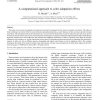Free Online Productivity Tools
i2Speak
i2Symbol
i2OCR
iTex2Img
iWeb2Print
iWeb2Shot
i2Type
iPdf2Split
iPdf2Merge
i2Bopomofo
i2Arabic
i2Style
i2Image
i2PDF
iLatex2Rtf
Sci2ools
IVC
2000
2000
A computational approach to color adaptation effects
The human vision system has adaptation mechanisms that cannot be managed with the classic tri-stimulus color theory. The effects of these mechanisms are clearly visible in some well-known perception phenomena as color illusions, but they are always present in human observation. The discrepancy between the observation of a real scene and the observation of a picture taken from the same scene, derives from the fact that the camera does not have such mechanisms. In this paper, we propose a biologically inspired implementation of the Retinex algorithm, introduced by Land and McCann, that simulates these adaptation mechanisms, in order to reproduce some effects like dynamic adjustment, color constancy, etc. typical of the human vision system. The algorithm has been tested not only on a Mondrian-like patchwork to measure its effect, but also on different pictures, photographs and typical color illusions to test its adaptation effects. The examples demonstrate the ability of the model to emu...
Color | Color Illusions | Human Vision | IVC 2000 |
| Added | 18 Dec 2010 |
| Updated | 18 Dec 2010 |
| Type | Journal |
| Year | 2000 |
| Where | IVC |
| Authors | Daniele Marini, Alessandro Rizzi |
Comments (0)

